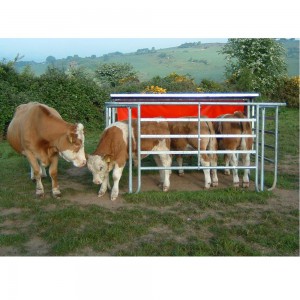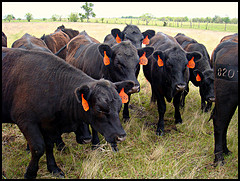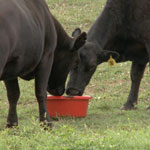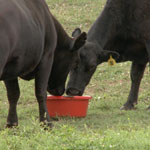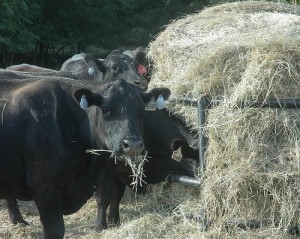Cobalt, copper, iodine, iron, manganese, selenium and zinc are trace minerals important to good cattle nutrition. Ranchers and feedlot operators need to know whether or not these minerals are available in their regions and supplement deficiencies accordingly. This TDN excerpts an article by Oklahoma State University animal nutritionist Fred Owens which identified the geographic availability of trace minerals. The original article appeared in the May, 1988 issue of Beef as “The Haves and the Have Nots.”
Cobalt
Moderate and extreme cobalt deficient areas exist primarily in the Central, Northeast and Southeast sections of the U.S. (Figure 1.) If cattle or feeds are obtained from these regions, deficiencies will be more likely. Cobalt levels calculated to be present in typical feedlot diets composed of corn, milo and wheat are .08, .19 and .15 parts per million (ppm). Compared with a .1 ppm requirement, the corn diet at .08 ppm is deficient by .02 ppm and must have cobalt supplemented.
Cobalt deficiency
One of the first signs of cobalt deficiency is a decreased appetite. Injections of cobalt or vitamin B-12 can stimulate the appetite of certain animals; for horses, B-12 injections are common. Vitamin B-12 often is included with vitamins A and D in injections for newly received cattle. As cobalt is a component of vitamin B-12, its requirement might increase with higher levels of propionate production in the rumen. Soil types vary in their cobalt level, and grasses are generally higher in cobalt than legumes.
Copper
Soils or plants in the upper Midwest, along the West Coast, in Florida and along the East Coast in the Virginia-Maryland area are low in copper (Figure 2). Copper deficiency also can occur in certain areas of the U.S., which have an excess of molybdenum (Figure 3), such as the Southwest, Florida and Central Texas. Cattle or feed from these areas may be deficient in copper.
The estimated requirement for copper by growing beef cattle was increased from 4 ppm in 1976 to 8 ppm in 1984. The new values are more similar to NRC (National Research Council) dairy requirements.
Dietary copper is tolerated by cattle at levels up to about 115 ppm. In contrast, the tolerance level for sheep fed a low molybdenum diet is only 8 to 11 ppm. When mineral supplements designed for cattle are fed to sheep, toxicities can occur.
With milo-based diets, one need not be concerned about copper, but with corn-based or wheat-based feedlot diets, 2 to 3 ppm of copper needs to be added.
Copper deficiency
With a severe copper deficiency, pigmentation of hair is reduced so that red cattle become yellow and black cattle become gray. Elevated levels of copper from copper sulfate may act as an antibiotic to depress ruminal fermentation.
Soil and plant copper concentrations vary. Young animals absorb copper more extensively than adult animals. High levels of sulfur, molybdenum, calcium and zinc each reduce absorption of copper and thereby increase its dietary requirement. Adequate copper is needed by the immune system, so a copper deficiency may cause animal health problems.
Iodine
Iodine is deficient in soils of plants across much of the Northern U.S. in the Goiter Belt (Figure 4). In addition, certain plants contain goitrogens that inhibit the use of iodine and increase its requirement.
The estimated iodine requirement for growing cattle is .5 ppm with a tolerance of 8 to 50 ppm. Corn-, milo- or wheat-based feedlot diets contain very little iodine and they all need iodine supplementation.
Iodine deficiency
An iodine deficiency decreases metabolic rate and causes goiter. Plants from low iodine soils have low iodine concentrations. Goitrogenic plants of wide renown and ill repute include those of the cabbage family, although goitrogens are also found in soybean meal, cottonseed meal and rapeseed meal.
Requirements for iodine vary with breed and age of animals. Under cold stress, the turnover rate of iodine increases, which may increase the need for dietary iodine. Castrated animals may require less iodine than do females, and females less than intact males.
A commonly used source of iodine in feeds is ethylenediaminedihydroiodine (EDDI). Some nutritionists have incorporated EDDI into diets as a preventative or cure for foot rot and soft tissue lumpy jaw. However, there is no scientific evidence substantiating the use of EDDI for those treatments. As a result, regulatory authorities have placed a maximum use level on the amount of EDDI that can be included in ruminant diets.
Iron
Iron present in soil often is unavailable to either plants or animals; thus, no mapping of soil or plant iron levels has been attempted. Iron availability varies widely with iron source.
Estimated iron requirements for steers have been increased by the NRC from 10 ppm (1976) to 50 ppm (1984). The iron tolerance level for cattle is from 400 to 1,000 ppm. Iron levels in corn, milo and wheat feedlot diets show that a wheat feedlot diet should be lowest, with a deficiency of 7 ppm.
Iron deficiency
As with deficiencies of many other minerals, a shortage of iron reduces rate of gain, a symptom that is hard to detect. Anemia also can occur. Iron loss is elevated by various abomasal or intestinal parasites that cause bleeding into the gut. One can measure iron status of animals by measuring the iron loading of the blood. Young animals need a much higher concentration of dietary iron than do older animals, probably because of expanding blood volume during growth.
Manganese
Manganese deficiencies of plants and grazing animals occur in the upper Midwest and along both coasts (Figure 5). Plants and soils as well as animals in these areas may have a marginal manganese status.
Estimated requirements for manganese range from 20 to 40 ppm and have been increased from the NRC (1976) estimate of 10 ppm. The tolerance level is about 1,000 ppm, indicating that excesses are well tolerated.
Corn-based feedlot diets are much lower in manganese than are milo- and wheat-based diets. To reach 40 ppm in the diet, 30 ppm needs to be added to the corn diet.
Manganese deficiency
Manganese deficiencies reduce growth rate. In 1951, Bentley and Phillips fed dairy cows diets containing 10 to 30 ppm manganese; three of the eight cows fed 10 ppm developed abscessed livers. Feeding 30 ppm prevented this problem. The effect of manganese on liver abscess incidence in beef cattle has not been tested.
High levels of calcium or phosphorus will increase the need for manganese. Soils vary in manganese content. In some regions, manganese is used as a fertilizer to increase plant production, which in turn can increase the manganese content of plants.
Selenium
Certain regions in the U.S. have topsoil and plants notably deficient in selenium (Figure 6). In other areas, toxicity of selenium is observed among grazing animals (Figure 7). In the Great Plains, toxicity has been of greater concern than deficiency. However, grain grown in the Eastern part of the Cornbelt and transported to the Great Plains probably will be low in selenium. Corn from some Oklahoma feedlots was recently found to be very low in selenium. This grain probably was imported from a low-selenium area of the U.S.
Selenium requirement estimates for growing beef cattle range from .1 to .2 ppm. The FDA recently approved supplementation with .3 ppm. As the tolerance for selenium is only 2 ppm, care is needed in selenium supplementation and in diet mixing.
Amounts found in various grains vary with their origin. According to the NRC, wheat-based diets are reasonably high in selenium content, while corn-based diets are low, possibly reflecting regional soil concentrations in the primary areas of production. With corn-based feedlot diets, to provide .2 ppm in the complete diet, one must add .13 ppm of selenium.
Selenium deficiency
Long touted as a panacea, selenium performs a number of functions in the body. Both selenium and vitamin E act as metabolic anti-oxidants. Selenium deficiency signs in cattle include white muscle disease and stiffness.
As many selenium compounds are quite volatile, it is necessary to have a good air control system and to use a gas mask when handling and mixing concentrated selenium premixes. Whenever the source of grain being fed in a diet is uncertain, it appears wise to consider that the grain was produced in a low-selenium region of the U.S. and to supplement accordingly. However, selenium supplementation should be avoided when grazing cattle in high-selenium areas of the U.S.
Zinc
Zinc is deficient in scattered areas of the Pacific Coast states plus Arizona and Utah, but the largest deficient areas are in the Southeast and Texas. Plants may have subnormal zinc levels in Wisconsin and Nebraska (Figure 8). One needs to be concerned about zinc with cattle or feed from these areas.
The requirement for zinc is estimated at 30 ppm, whereas the tolerance is 500 to 1,300 ppm. Corn- and milo-based feedlot diets provide 19 to 21 ppm of zinc, while wheat is considerably richer. For corn and milo diets, some 11 ppm needs to be added.
Zinc deficiency
Signs of zinc deficiency include reduced feed intake and rate of gain. In the human, zinc deficiency causes taste problems, both with loss of acuity and abnormal taste sensations. Another common sign of zinc deficiency is parakeratosis. Scabs and white patches of hair appear on the flanks of zinc-deficient cattle and swine.
Certain genetic strains of Friesian cattle rapidly excrete zinc and they need extremely high levels of zinc to compensate for this. Whether this problem occurs in other breeds of cattle is unknown.
High dietary calcium levels reduce zinc availability and increase its excretion. Infections also can reduce plasma levels of zinc. Rate of wound healing is slowed by a zinc deficiency and the incidence of foot rot has been reported elevated by a zinc deficiency.
Males have more problems with zinc deficiency than females, so zinc may be more critical in diets for steers than for heifers.
Source: Purina Mills
